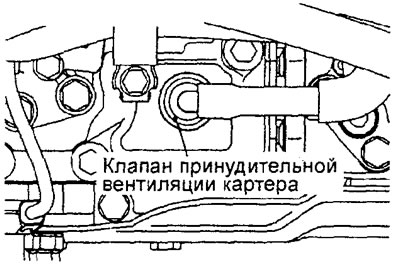General information
In order to ensure optimal crankcase gas flow, the stroke of the positive crankcase ventilation valve plunger always depends on the vacuum in the intake manifold. At low engine loads, crankcase gas flow is limited to ensure stable engine operation, and as load increases, crankcase gas flow through the valve increases to increase the efficiency of crankcase ventilation.
System check
1. Disconnect the ventilation hose from the positive crankcase ventilation valve.

GDI engine.

MPI engine.
2. Remove the positive crankcase ventilation valve from the cylinder head cover.
3. Connect the positive crankcase ventilation valve to the ventilation hose.
4. Start the engine and let it idle.
5. Close the valve opening with your finger, and check for vacuum in the intake manifold.
Note: At this point, the positive crankcase breather valve plunger moves back and forth.
6. If vacuum is not felt, clean the positive crankcase ventilation valve with solvent or replace the valve if necessary.

7. Reinstall the positive crankcase ventilation valve.
Checking the positive crankcase ventilation valve
1. Remove the positive crankcase ventilation valve from the cylinder head cover.
2. Insert a thin rod into the positive crankcase ventilation valve from the side of the threaded part and, moving the rod back and forth (about 5 - 10 mm), check that the plunger moves (under the action of the valve spring).

3. If the plunger does not move or moves very slowly, there is deposits in the PCV valve. In this case, it is necessary to clean or replace the valve.
